Input interpretation

carbon dioxide + potassium superoxide ⟶ oxygen + pearl ash
Balanced equation
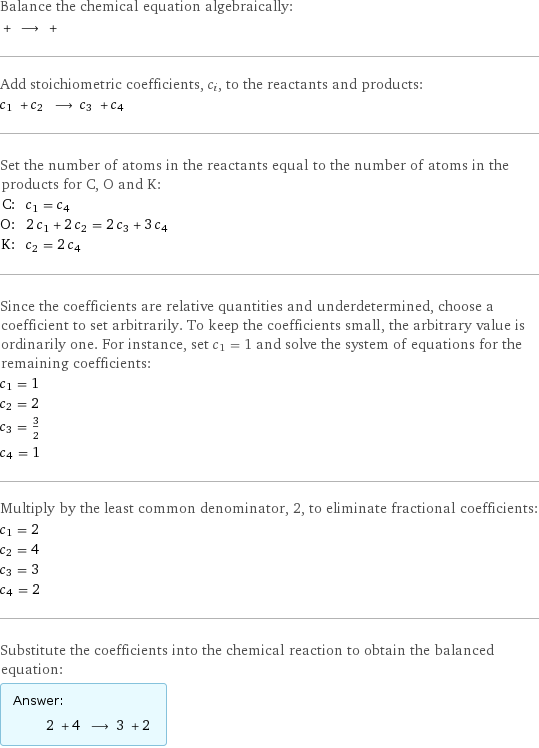
Balance the chemical equation algebraically: + ⟶ + Add stoichiometric coefficients, c_i, to the reactants and products: c_1 + c_2 ⟶ c_3 + c_4 Set the number of atoms in the reactants equal to the number of atoms in the products for C, O and K: C: | c_1 = c_4 O: | 2 c_1 + 2 c_2 = 2 c_3 + 3 c_4 K: | c_2 = 2 c_4 Since the coefficients are relative quantities and underdetermined, choose a coefficient to set arbitrarily. To keep the coefficients small, the arbitrary value is ordinarily one. For instance, set c_1 = 1 and solve the system of equations for the remaining coefficients: c_1 = 1 c_2 = 2 c_3 = 3/2 c_4 = 1 Multiply by the least common denominator, 2, to eliminate fractional coefficients: c_1 = 2 c_2 = 4 c_3 = 3 c_4 = 2 Substitute the coefficients into the chemical reaction to obtain the balanced equation: Answer: | | 2 + 4 ⟶ 3 + 2
Structures
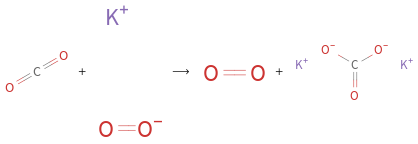
+ ⟶ +
Names

carbon dioxide + potassium superoxide ⟶ oxygen + pearl ash
Reaction thermodynamics
Enthalpy
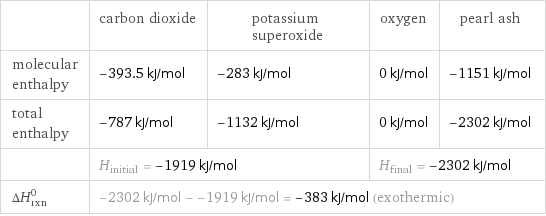
| carbon dioxide | potassium superoxide | oxygen | pearl ash molecular enthalpy | -393.5 kJ/mol | -283 kJ/mol | 0 kJ/mol | -1151 kJ/mol total enthalpy | -787 kJ/mol | -1132 kJ/mol | 0 kJ/mol | -2302 kJ/mol | H_initial = -1919 kJ/mol | | H_final = -2302 kJ/mol | ΔH_rxn^0 | -2302 kJ/mol - -1919 kJ/mol = -383 kJ/mol (exothermic) | | |
Gibbs free energy

| carbon dioxide | potassium superoxide | oxygen | pearl ash molecular free energy | -394.4 kJ/mol | -239.4 kJ/mol | 231.7 kJ/mol | -1064 kJ/mol total free energy | -788.8 kJ/mol | -957.6 kJ/mol | 695.1 kJ/mol | -2127 kJ/mol | G_initial = -1746 kJ/mol | | G_final = -1432 kJ/mol | ΔG_rxn^0 | -1432 kJ/mol - -1746 kJ/mol = 314.5 kJ/mol (endergonic) | | |
Chemical names and formulas
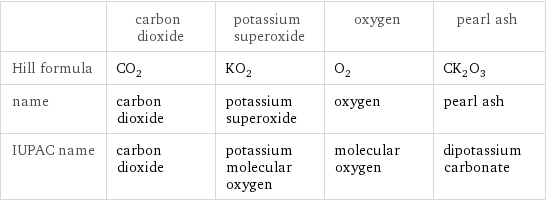
| carbon dioxide | potassium superoxide | oxygen | pearl ash Hill formula | CO_2 | KO_2 | O_2 | CK_2O_3 name | carbon dioxide | potassium superoxide | oxygen | pearl ash IUPAC name | carbon dioxide | potassium molecular oxygen | molecular oxygen | dipotassium carbonate
Substance properties
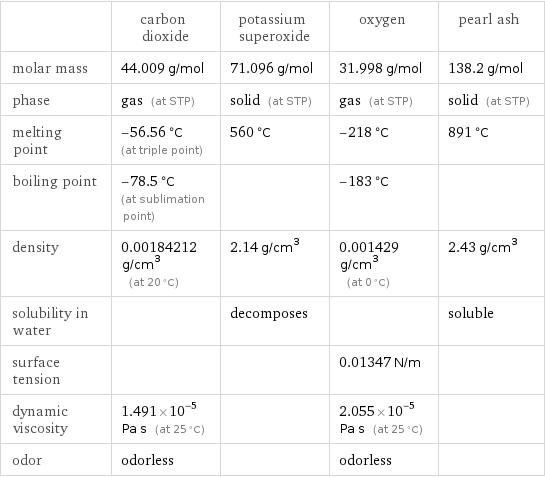
| carbon dioxide | potassium superoxide | oxygen | pearl ash molar mass | 44.009 g/mol | 71.096 g/mol | 31.998 g/mol | 138.2 g/mol phase | gas (at STP) | solid (at STP) | gas (at STP) | solid (at STP) melting point | -56.56 °C (at triple point) | 560 °C | -218 °C | 891 °C boiling point | -78.5 °C (at sublimation point) | | -183 °C | density | 0.00184212 g/cm^3 (at 20 °C) | 2.14 g/cm^3 | 0.001429 g/cm^3 (at 0 °C) | 2.43 g/cm^3 solubility in water | | decomposes | | soluble surface tension | | | 0.01347 N/m | dynamic viscosity | 1.491×10^-5 Pa s (at 25 °C) | | 2.055×10^-5 Pa s (at 25 °C) | odor | odorless | | odorless |
Units
